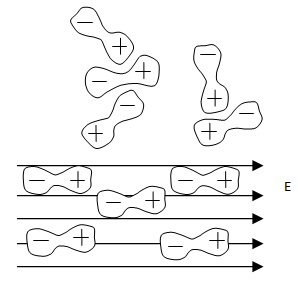Theory Of Dielectrics
Theory Of Dielectrics Assignment Help | Theory Of Dielectrics Homework Help
Theory of Dielectrics
Dielectrics.
A dielectric (or an insulator) is a material in which all the electrons are tightly bound to the nuclei of the atoms. Thus there are no free electrons to carry current. Hence the electrical conductivity of a dielectric is very low. Glass, ebonite, mica, rubber, oils etc., are examples of dielectric.Dielectric Constant. The ratio of the capacitance of a given capacitor with the material filling the entire space between its plates to the capacitance of the same capacitor in vacuum is called the dielectric constant or relative permittivity of the material.
Thus if C is the capacitance with dielectric material, and C0 that in vacuum, then dielectric constant of the material = K = C/C0.
Polarization of Dielectric. A nonpolar molecular is one in which the centre of gravity of the positive charges (protons) coincides with the centre of gravity of the negative charges (electrons). Symmetrical molecules are non polar. A non polar molecule has obviously a zero electric dipole moment. If the dielectric is placed in an electric field, the charge centres of an non-polar molecular become displaced. The molecules are then said to become polarized by the field and are called induced dipoles. The molecules thus acquire an induced electric-dipole moment in the direction of field.
A polar molecule is one in which the centre of gravity of the positive charges is separated from the centre of gravity of the negative charges by a finite distance. The polar molecule is thus an electric dipole and has an intrinsic permanent electric-dipole moment. In the absence of say external electric field, the individual dipoles (molecules) are oriented at random and no net dipole moment is observed in the dielectric. When an electric field is applied, the forces on a dipole give rise to a torque, whose effect is to orient the dipole along the direction of electric field. The stronger the field, the greater is the aligning effect. The alignment is, however, incomplete due to the thermal agitation of the molecules. (The alignment becomes more and more perfect as the electric field is increased of the temperature is decreased). Hence a net dipole moment is produced in the dielectric. Thus non-polar molecules become induced dipoles, whereas polar molecules are oriented by the field and therefore have their dipole moment increased. The orientation of the induced dipoles or of the permanent dipoles in an external electrostatic field is such as to set the axis of the dipole along the field. This phenomenon is known as electric polarization.
The magnitude of the induced dipole moment p is found to be directly proportional to the magnitude of the external electric field E. The direction of the induced dipole moment P is parallel to the direction of the electric field E. That is
p ∞ E, or p = α E.
The constant of proportionality α is called molecular polarizability or the dielectric.
Electric Polarization P is defined as the product of P, the component of the vector dipole moment of each molecule in the field direction and n the number of molecules per unit volume.
P = np.
Thus polarization P is defined as the dipole moment per unit volume. It has the same direction as that of p and hence of electric field E. Unit of p is coulomb meter/meter3 or coulomb/meter2
